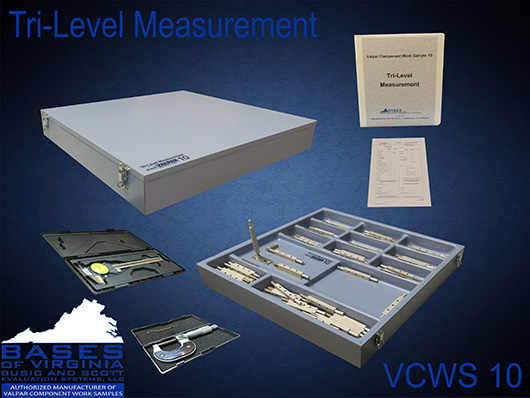Click here to shop for VCWS 10 Tri-Level Measurement parts and supplies
Purpose:To assess work skills related to inspection and measurement tasks, ranging from simple to very precise. The work sample simulates light work and makes the following physical demands upon the evaluee: reaching, handling, fingering, feeling, near acuity, depth perception, and accommodation. Significant form perception, finger dexterity, manual dexterity, spatial aptitude, and clerical perception are required to perform the work sample at a competitive level.
The work sample elicits information on several work-related characteristics, including, among others, the ability to follow instructions, concentration skills, problem conceptualization, and self-confidence.
The work sample is well suited to work-hardening uses.
Design:VCWS 10 has one hands-on exercise in which the evaluee uses a variety of instruments to determine if machined parts fit specifications.
Special Features:Scores may be interpreted against criterion-referenced standards, supplied norms, or locally developed norms. The work sample may be used with disabled or nondisabled persons. A VCWS#10 B-Kit — adaptations for visually impaired or blind persons — is available.
Information Collected:The work sample has been analyzed according to U.S. Department of Labor job analysis techniques. The result of the analysis is a list of rated DOL work-related abilities and other factors that are required for successful work sample performance (Worker Qualifications Profile). Valpar uses Methods-Time Measurement (MTM) to establish industrial work rate standards for the work sample.
Procedure:In its standard format, the work sample takes approximately 25 minutes to administer, including two exercise cycles. (Two administrations are recommended — but not required — due to the short duration of the exercise.)
The evaluee sits in front of the work sample and inspects a total of 61 machined parts, including eleven practice parts. The parts are sorted into nine compartments depending on their measurements and other aspects, which are determined by the evaluee through the use of his or her eyes, a ruler, jigs, a micrometer, and a vernier caliper. The same inspection procedure is followed for each part until or unless it fails a particular test. Defects in the parts range from very obvious malformations to subtle imperfections in length, width, or diameter.
Components:The work sample is a square box, 23 1/2″ x 3″ made of particle board and covered with blue, plastic laminate. The work surface is divided into three main sections. The top section contains nine labeled compartments into which the parts are sorted. The middle section contains a micrometer, a vernier caliper, two mounted inspection jigs, and a mounted 6″ ruler. The bottom portion of the box is divided into two trays, one containing 11 practice parts, and the other containing the remaining 50 machined parts. Mounted on the inside lid are diagrams showing the flaws which characterize the various machined parts. The work sample comes with a pad of 100 scoring sheets and a manual.
Shipping Weight: 1 carton @ 26″ x 26″ x 10″ – 45 lbs.

